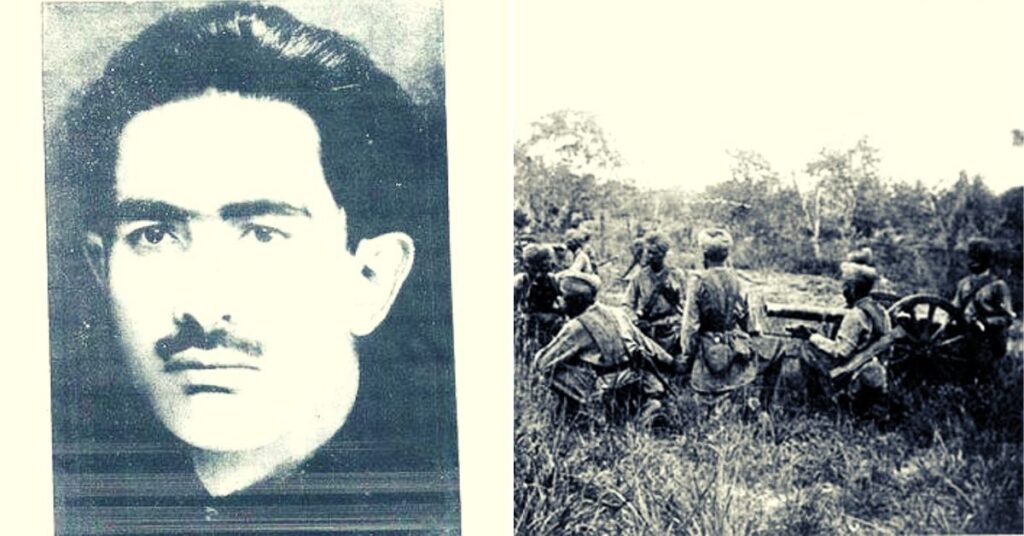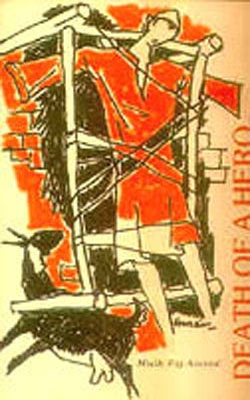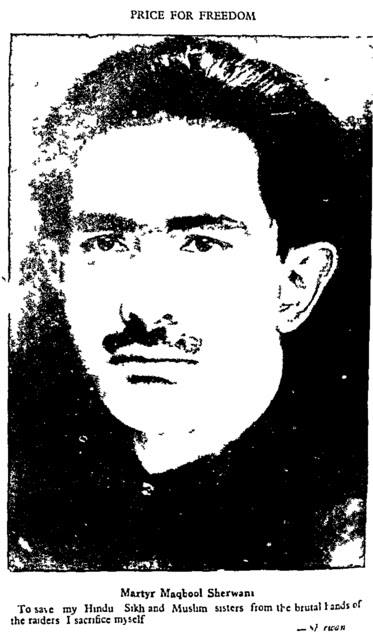Baramulla, JAMMU & KASHMIR :
Maqbool Sherwani, a 19-year-old National Conference party worker, has been credited with singlehandedly stalling the advance of Pakistan-sponsored tribal raiders to Srinagar.

On 26 October 1947, Maharaja Hari Singh, the ruler of the erstwhile princely state of Jammu and Kashmir signed the Instrument of Accession with the Government of India. Despite the official accession, the situation on the ground was in a real state of flux.
(Photo above: Left-Maqbool Sherwani, Right-Indian soldiers in the ’47 War. Source: Facebook/Wikimedia Commons)
There was an invasion by Pakistan-sponsored tribal raiders from the North-West Frontier Province (NWFP). The Indian armed forces were still days away from getting troops on the ground. At the same time, the Pakistan-sponsored raiders had already made their way to Baramulla, a mere 54 km away from Srinagar, just days before the signing of the Instrument of Accession.
If Srinagar had fallen to the tribal raiders, many commentators believe that the outcome of the 1947 war would have been very different. But it was the sacrifice of one 19-year-old political worker of the National Conference party from Baramulla, Maqbool Sherwani, ensured that the Indian armed forces had enough time to thwart the raiders.
One Hero, Many Versions
There are two popular versions of how he ensured that the raiders would not proceed to Srinagar. According to one version, Maqbool told the raiders that he would show them the way to Srinagar and led them astray. This gave the Indian Army time to land at Srinagar airport on 27 October.
Another version of the story notes that on 22 October, when the Pakistan-sponsored raiders stormed Baramulla, Maqbool thought of a ruse to put them off track. He told them that the Indian Army had already landed in Srinagar. This reportedly stalled their advance towards Srinagar. Eventually, they were intercepted by the Indian Army at Shalteng, a few kilometres outside Srinagar on 7 November and driven out altogether.
However, what’s not in question is that the raiders brutally executed him for misleading them. Sherwani was in Sumbal, which is about 35 km away from Baramulla when the Pakistan-sponsored raiders found out about his ruse and brought him back.
According to report filed by the Times of India correspondent, who visited Baramulla on 9 November, the day after the Indian Army captured the town, “the most popular local leader of the National Conference, Meer Maqbool Sherwani, went through torture for his politics and was finally bound to wooden bars and shot dead—14 bullet holes were found in his body.”
Other reports spoke of how the raiders had even posted a note on his forehead in Urdu stating, ‘He is a traitor, his punishment is death’ before nailing his body to a wooden plank. Many Indian commentators believe he is a hero who turned the tide of a 1947 war. After the raiders were driven out of Baramulla, his body was buried with full military honours.
Mulk Raj Anand, the author, wrote a novella in his honour called ‘Death of a Hero’.

Novel – Death of a Hero – author: Mulk Raj Anand / pix: amazon.in
“To his grandchildren, my grandfather, who was Deputy Commissioner (Wazir-i-Wazarat, as the position was known then) of the district from 1948 to 1954, described Sherwani as the one man who saved Kashmir for India,” notes Amitabh Mattoo, a Professor of International Relations at Jawaharlal Nehru University, in The Hindu .

Maqbool Sherwani of Kashmir (Image courtesy Facebook/Images and Culture of J&K)
Understanding Maqbool Sherwani
As a political worker in Baramulla for the National Conference, a party established by Sheikh Abdullah, Maqbool idolised Sheikh Abdullah and did the party’s bidding in Baramulla.
In a conversation with Scroll.in , Khaliq Parvaiz said how one day when he was sitting on a ghat by the Jhelum river in Baramulla, he saw Maqbool being chased by some rival political workers.
However, he escaped their clutches after jumping into the river and swimming to safety. Although many didn’t agree with his politics, what people agreed on was that he was “something of a hellraiser, a swashbuckling character who could impress the crowds”.
In fact, Parvaiz adds, “He did not know how to ride a bike, he learnt in three days to lead the raiders astray. Kashmiris knew he was a khatarnak [deadly] person.”
Similarly, there are stories of how he tried to disrupt a public address of Mohammed Ali Jinnah, who had arrived in Baramulla on 25 July 1944.
Margeret Bourke White, a reporter for Life magazine, who visited Baramulla in December 1947, described Maqbool as an “a sort of Robin Hood character, from the stories the townspeople told me” and portrayed him as a staunch believer of religious tolerance who sought to frustrate the raiders in their advance towards Srinagar.
In fact, according to some accounts, moments before the raiders executed him, Maqbool is believed to have shouted “Victory for the unity of Sikh, Hindus and Muslims”. In a prayer meeting later, Mahatma Gandhi recalled how Maqbool’s act “was a martyrdom of which anyone, Hindu, Sikh, Muslim or any other, would be proud [of].”
Others, however, are less charitable in their description of Maqbool. Historian Andrew Whitehead, a renowned scholar of the region, writes about his encounter with Muhammad Yusuf Saraf, a rival political activist from Baramulla, who referred to Maqbool as a “semi-literate man of about 40 years” who had become “very unpopular for his goondaism.”
“Saraf, however, acknowledged both Sherwani’s devotion to Sheikh Abdullah and the courage with which he sought to impede the lashkar advance and approached his own death,” writes Whitehead.
In fact, Saraf went on to recall events as he remembered.
“He was brought down to Baramulla and after several days of interrogation, was tied to an electric pole in the centre of the town and nails were driven into his hands and forehead. Ultimately he was shot dead. How fanatically devoted he was to his leader and basically how brave he was, maybe judged from the fact that even while he was so nailed, he continued to shout ‘Sher-e-Kashmir Zindabad’ [Long Live the Lion of Kashmir – a title for Abdullah],” said Saraf.
Whitehead recalls another encounter with Pran Nath Jalali, who had spent time in the Maharaja’s prisons with Maqbool and went on to join the National Conference militia.
“Jalali told me that Sherwani was among those who offered to go undercover into areas controlled by the tribesmen. ‘In fact, there was a list of 22 volunteers which we framed to go behind the enemy lines. [Sherwani] was one of them. But being an adventurer and a bit showy—he held public meetings village to village and rode into the enemy on a motorbike. That motorbike undid him.’ Sherwani was, as far as Jalali recalled, the only one of these behind-the-lines militia volunteers to lose his life,” writes Whitehead.
The bravery and subsequent martyrdom of Maqbool Sherwani in 1947 and the story of his role during the Pakistan-backed invasion of Kashmir needs to be mainstreamed throughout India- Prof. @amitabhmattoo /National Symposium and Virtual Exhibition Live on the ‘Memories of #22OCT1947‘ pic.twitter.com/q17ljOjBAF
— Ministry of Culture (@MinOfCultureGoI) October 18, 2020
Whatever said and done, Maqbool lost his life in service of a nascent Indian nation that was still struggling to come to terms with the violence and chaos surrounding its birth. In risking his life, he significantly contributed to giving India a serious foothold in the Kashmir Valley when all seemed lost.
(Edited by Vinayak Hegde)
source: http://www.thebetterindia.com / The Better India /Home> Stories> History> Jammu & Kashmir / by Rinchen Nobu Wangchuk / edited by Vinayak Hegde / October 21st, 2020 / Notes pix of Novel – Death of a Hero – author: Mulk Raj Anand, pix: amazon.in added /








